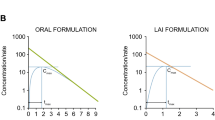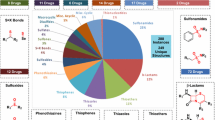Abstract
We reported that 2-(3,4-difluorophenylethynyl)-N 6-3-chlorobenzyl (N)-methanocarba adenosine derivative 1 (MRS5698) binds selectively to human and mouse A3 adenosine receptors (A3ARs, K i 3 nM). It is becoming an important pharmacological tool for defining A3AR effects and is orally active in a chronic neuropathic pain model. Here, we introduce a new synthetic route for MRS5698 from d-ribose, suitable for a scale-up on a multi-gram scale, and we measure in vitro and in vivo ADME-Tox parameters. MRS5698 was very stable in vitro, failed to inhibit CYPs at <10 μM, and was largely bound to plasma proteins. It was well tolerated in the rat at doses of ≤200 mg/kg i.p. A 1 mg/kg i.p. dose in the mouse displayed t 1/2 of 1.09 h and plasma Cmax of 204 nM at 1 h with an AUC of 213 ng × h/mL. CACO-2 bidirectional transport studies suggested intestinal efflux of MRS5698 (efflux ratio 86). Although the oral %F is only 5 %, the beneficial effect to reverse pain lasted for at least 2 h in the CCI model in rats, using the same vehicle for oral administration of a high dose. The stability, low toxicity, lack of CYP interaction, pharmacokinetic half-life, and in vivo efficacy suggest that MRS5698 is a preferred compound for further consideration as a treatment for neuropathic pain.





Similar content being viewed by others
Abbreviations
- ADME:
-
Absorption, distribution, metabolism, and excretion
- AR:
-
Adenosine receptor
- CCI:
-
Chronic constriction injury
- CHO:
-
Chinese hamster ovary
- CIPN:
-
Chemotherapy-induced peripheral neuropathy
- Cl-IB-MECA:
-
1-deoxy-1-[2-chloro-6-[[(3-iodophenyl)methyl]amino]-9H-purin-9-yl]-N-methyl-β-d-ribofuranuronamide
- CNS:
-
Central nervous system
- CYP:
-
Cytochrome P450
- DMF:
-
N,N-dimethylformamide
- DCC:
-
Dicyclohexylcarbodiimide
- DMSO:
-
Dimethylsulfoxide
- EDC:
-
N-(3-Dimethylaminopropyl)-N′-ethylcarbodiimide
- EL:
-
Extracellular loop
- GMP:
-
Good manufacturing practice
- GPCR:
-
G protein-coupled receptor
- HEPES:
-
4-(2-Hydroxyethyl)-1-piperazineethanesulfonic acid
- HOBt:
-
1-Hydroxybenzyltriazole
- HP-β-CD:
-
2-Hydroxypropyl-β-cyclodextrin
- HRMS:
-
High resolution mass spectroscopy
- IB-MECA:
-
1-Deoxy-1-[6-[[(3-iodophenyl)methyl]amino]-9H-purin-9-yl]-N-methyl-β-d-ribofuranuronamide
- IND:
-
Investigational New Drug
- MRS5698:
-
(1S,2R,3S,4R,5S)-4-(6-((3-Chlorobenzyl)amino)-2-((3,4-difluorophenyl)ethynyl)-9H-purin-9-yl)-2,3-dihydroxy-N-methylbicyclo[3.1.0]hexane-1-carboxamide
- MTD:
-
Maximum tolerated dose
- MW:
-
Molecular weight
- NMR:
-
Nuclear magnetic resonance
- PBS:
-
Phosphate-buffered saline
- PDC:
-
Pyridinum dichromate
- PEG:
-
Polyethylene glycol
- PK:
-
Pharmacokinetic
- PWT:
-
Paw withdrawal threshold
- SAR:
-
Structure-affinity relationship
- SGF:
-
Stimulated gastric fluid
- SGF:
-
Stimulated intestinal fluid
- trp:
-
Tryptophan
- TBAF:
-
Tetra-n-butylammonium fluoride
- TBDPS:
-
tert-Butyldiphenylsilyl
- TEER:
-
Transepithelial electrical resistance
- TFA:
-
Trifluoroacetic acid
- THF:
-
Tetrahydrofuran
- XTT:
-
2,3-Bis-(2-methoxy-4-nitro-5-sulfophenyl)-2H-tetrazolium-5-carboxanilide
References
Renfrey S, Downton C, Featherstone J (2003) The painful reality. Nat Rev Drug Discov 2:175–176
Grosser T, Fries S, FitzGerald GA (2006) Biological basis for the cardiovascular consequences of COX-2 inhibition: therapeutic challenges and opportunities. J Clin Invest 116:4–15
Mao J, Price DD, Mayer DJ (1998) Mechanisms of hyperalgesia and morphine tolerance: a current view of their possible interactions. Pain 62:259–274
Arner S, Rawal N, Gustafsson LL (1988) Clinical experience of long-term treatment with epidural and intrathecal opioids—a nationwide survey. Acta Anaesthesiol Scand 32:253–259
Ossipov MH, Lai J, King T, Vanderah TW, Malan TP Jr, Hruby VJ et al (2004) Antinociceptive and nociceptive actions of opioids. J Neurobiol 61:126–148
Torrance N, Smith BH, Bennett MI, Lee AJ (2006) The epidemiology of chronic pain of predominantly neuropathic origin. Results from a general population survey. J Pain 7:281–289
Cata JP, Weng HR, Lee BN, Reuben JM, Dougherty PM (2006) Clinical and experimental findings in humans and animals with chemotherapy-induced peripheral neuropathy. Minerva Anesthesiol 72:151–169
Farquhar-Smith P (2011) Chemotherapy-induced neuropathic pain. Curr Opin Support Palliat Care 5:1–7
Chen Z, Janes K, Chen C, Doyle T, Tosh DK, Jacobson KA et al (2012) Controlling murine and rat chronic pain through A3 adenosine receptor activation. FASEB J 26:1855–1865
Janes K, Wahlman C, Little J, Doyle T, Tosh DK, Jacobson KA et al (2015) Spinal neuroimmmune activation is independent of T-cell infiltration and attenuated by A3 adenosine receptor agonists in a model of oxaliplatin-induced peripheral neuropathy. Brain Behav Immun 44:91–99
Ford A, Castonguay A, Cottet M, Little JW, Chen Z, Liguori A et al (2015) Engagement of the GABA to KCC2 signaling pathway contributes to the analgesic effects of A3AR agonists in neuropathic pain. J Neurosci 35:6057–6067
Tosh DK, Deflorian F, Phan K, Gao ZG, Wan TC, Gizewski E et al (2012) Structure-guided design of A3 adenosine receptor-selective nucleosides: combination of 2-arylethynyl and bicyclo[3.1.0]hexane substitutions. J Med Chem 55:4847–4860
Fishman P, Bar-Yehuda S, Liang BT, Jacobson KA (2012) Pharmacological and therapeutic effects of A3 adenosine receptor (A3AR) agonists. Drug Discov Today 17:359–366
Paoletta S, Tosh DK, Salvemini D, Jacobson KA (2014) Structural probing of off-target G protein-coupled receptor activities within a series of adenosine/adenine congeners. PLoS ONE 9, e97858. doi:10.1371/journal.pone.0097858
Little JW, Ford A, Symons-Liguori AM, Chen Z, Janes K, Doyle T et al (2015) Endogenous adenosine A3 receptor activation selectively alleviates persistent pain states. Brain 138:28–35
Bennett GJ, Xie YK (1988) A peripheral mononeuropathy in rat that produces disorders of pain sensation like those seen in man. Pain 33:87–107
Di Sotto A, Maffei F, Hrelia P, Di Giacomo S, Pagano E, Borrelli F et al (2014) Genotoxicity assessment of some cosmetic and food additives. Regul Toxicol Pharmacol 68:16–22
Di Sotto A, Evandri MG, Mazzanti G (2008) Antimutagenic and mutagenic activities of some terpenes in the bacterial reverse mutation assay. Mutat Res 653:130–133
Dixon WJ (1980) Efficient analysis of experimental observations. Annu Rev Pharmacol Toxicol 20:441–462
Choi WJ, Moon HR, Kim HO, Yoo BN, Lee JA, Shin DH et al (2004) Preparative and stereoselective synthesis of the versatile intermediate for carbocyclic nucleosides: effects of the bulky protecting groups to enforce facial selectivity. J Org Chem 69:2634–2636
Lee JA, Kim HO, Tosh DK, Moon HP, Kim S et al (2006) Stereoselective synthesis of 2’-C-methyl-cyclopropyl-fused carbanucleosides as potential anti-HCV agents. Org Lett 8:5081–5083
Michel BY, Strazewski P (2009) Total syntheses of a conformationally locked north-type methanocarba puromycin analogue and a dinucleotide derivative. Chem Eur J 15:6244–6257
Joshi BV, Melman A, Mackman RL, Jacobson KA (2008) Synthesis of ethyl (1S,2R,3S,4S,5S)-2,3-O-(isopropylidene)-4-hydroxy-bicyclo[3.1.0]hexane-carboxylate from L-ribose: a versatile chiral synthon for preparation of adenosine and P2 receptor ligands. Nucleosides Nucleotides Nucleic Acids 27:279–291
Balcar H, Shinde T, Naděžda Žilková N, Bastl Z (2011) Hoveyda–Grubbs type metathesis catalyst immobilized on mesoporous molecular sieves MCM-41 and SBA-15. Beilstein J Org Chem 7:22–28
Lipinski CA, Lombardo F, Dominy BW, Feeney PJ (2001) Experimental and computational approaches to estimate solubility and permeability in drug discovery and development settings. Adv Drug Deliv Rev 46:3–26
Rankovic Z (2015) CNS drug design: balancing physicochemical properties for optimal brain exposure. J Med Chem. doi:10.1021/jm501535r
Veber DF, Johnson SR, Cheng HY, Smith BR, Ward KW, Kopple KD (2002) Molecular properties that influence the oral bioavailability of drug candidates. J Med Chem 45:2615–2623
Pires DEV, Blundell TL, Ascher DB (2015) pkCSM: predicting small-molecule pharmacokinetic properties using graph-based signatures. J Med Chem 58:4066–4072
Schoonen WG, de Roos JA, Westerink WM, Débiton E (2005) Cytotoxic effects of 110 reference compounds on HepG2 cells and for 60 compounds on HeLa, ECC-1 and CHO cells. II mechanistic assays on NAD(P)H, ATP and DNA contents. Toxicol In Vitro 19(4):491–503
Tosh DK, Finley A, Paoletta S, Moss SM, Gao ZG, Gizewski E et al (2014) In vivo phenotypic screening for treating chronic neuropathic pain: modification of C2-arylethynyl group of conformationally constrained A3 adenosine receptor agonists. J Med Chem 57:9901–9914
Acknowledgments
This research was supported in part by the Intramural Research Program of the NIH, National Institute of Diabetes and Digestive and Kidney Diseases (Z01 DK031117-27), and National Cancer Institute (R01CA169519). We thank Dr. Bryan L. Roth (University of North Carolina at Chapel Hill) and the National Institute of Mental Health’s Psychoactive Drug Screening Program (Contract # HHSN-271-2008-00025-C) for hERG screening data.
Author information
Authors and Affiliations
Corresponding author
Electronic supplementary material
Below is the link to the electronic supplementary material.
ESM 1
(DOCX 3766 kb)
Rights and permissions
About this article
Cite this article
Tosh, D.K., Padia, J., Salvemini, D. et al. Efficient, large-scale synthesis and preclinical studies of MRS5698, a highly selective A3 adenosine receptor agonist that protects against chronic neuropathic pain. Purinergic Signalling 11, 371–387 (2015). https://doi.org/10.1007/s11302-015-9459-2
Received:
Accepted:
Published:
Issue Date:
DOI: https://doi.org/10.1007/s11302-015-9459-2




